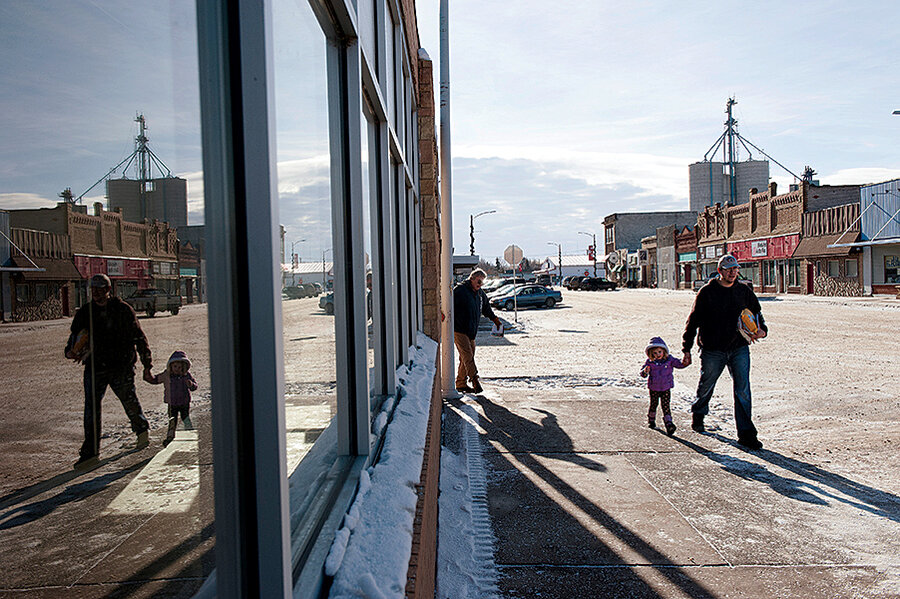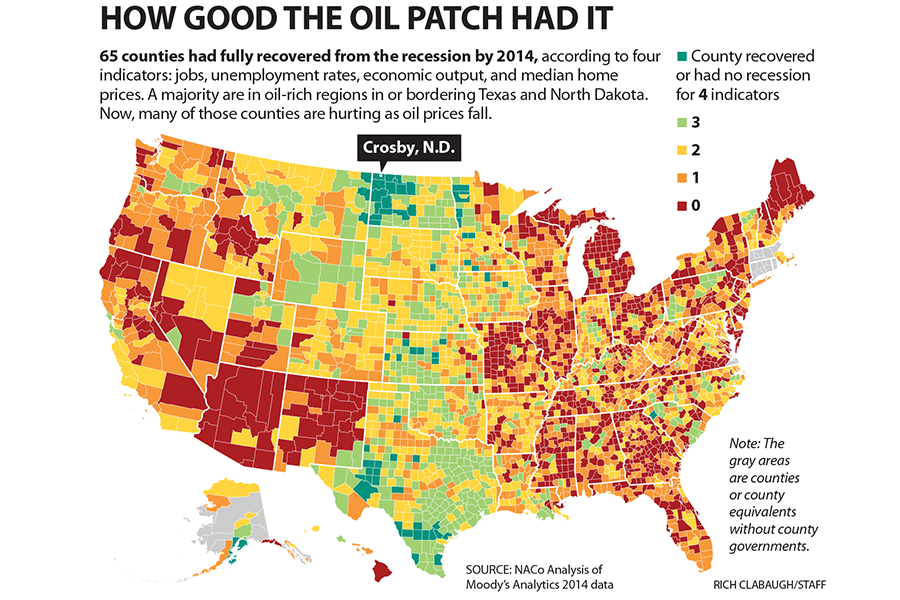Low oil prices chill a once-hot oil town in North Dakota
Loading...
| Crosby, N.D.
An empty strip of gravel – lined with streetlights and unused utility hookups – runs next to the highway, south of a once-booming oil town.
A few years ago, city officials anticipated oil field companies and other businesses would fill up the 230-acre strip. The city spent $1.7 million on the land, with another $9 million coming from state oil impact grants. There was talk of 300 housing units popping up in the fields behind the commercial street. The former mayor said the 1,300-person town was preparing to potentially double or triple in size.
But there is only one building along the road today. At night the streetlights shine on the gravel, illuminating flurries of snow that semi trucks have whipped off the nearby highway down onto the deserted street. To the south, farmland rambles into the middle distance, dotted with nodding pump jacks extracting oil, flares burning off gas, and idle, darkened drilling rigs.
“The year they proposed this they could have gotten quite a bit of commerce in there – but now? It’s like a street to nowhere. You’ve got streetlights on and nobody’s home,” says Cecile Krimm, editor of the county’s newspaper, The Journal.
Emptiness along the newly built road is a portrait of the “echo economy” – an America that looks at plummeting oil prices not as a sign of savings at the pump, but as potential trouble ahead. They are towns as remote as Crosby, where the recent oil boom drove rents to San Francisco levels, or as familiar as Houston, a metropolis bracing for as many as 75,000 layoffs.
This is the country’s echo economy. While the rest of the country struggled through a recession, these beneficiaries of the shale boom helped prop up the economy. The oil and gas industry created more than 100,000 US jobs between 2007 and 2013 – a 40 percent increase in US energy industry jobs and a 1 percent boost in total US employment. But as the national economy has found firmer footing, the drop of oil prices to five-year lows has begun to turn the tables on towns like Crosby.
In many ways, this lonely swath of North Dakota is a bellwether for America’s energy economy. Twenty-two of the 65 American counties that had fully recovered from the recession by 2014 were in or bordering North Dakota, according to a study by the National Association of Counties. Only Texas (with 24) accounted for more. So when Crosby’s once-bustling Main Street is less harried than it once was, and when fewer landmen are crowding into the rotunda of the county courthouse to scour mineral rights records for Divide County, it is a hint that oil-dependent towns from Ohio to California might soon be feeling the pinch.
For Crosby, the oil boom of the past decade has come with a catch: The cost of getting oil out of the ground is high here. Unless the price of oil tops $73 a barrel, producers in Divide County can’t break even. For years, that’s hardly been a problem, with oil consistently trading for more than $100 a barrel. As of mid-January, however, US crude is below $50 a barrel.
Oil production is costly in Crosby because it sits on the very fringe of North Dakota’s oil-rich Bakken region. The Bakken is essentially a bowl beneath North Dakota’s northwestern quadrant with more oil concentrated in the center where the bowl is deepest. Crosby is perched on the frigid northern rim, a few miles from Canada.
Being at the rim means less oil.
“We’re on the edge, and that won’t be to our advantage if oil prices continue to go down,” says Bert Anderson, Crosby’s affable mayor for most of the past 30 years.
Oil has revived his town, Mayor Anderson says, sitting in a sturdy wooden chair and peering at Main Street through the window of his shop, Bert’s Woodworks. The surroundings are a portrait of the modest farming town Crosby once was. Newspaper clippings from The Journal yellow on the door that opens to the back room, and a rainbow of paint chips hang on one wall. On another wall are a series of bald eagle prints next to a portrait of Cosmo Kramer from “Seinfeld.”
For now, Anderson is confident oil prices will rebound. Almost everyone in Crosby is optimistic. Anderson notes that several vacant lots along the empty road south of town are sold. They’re just waiting for development.
And even as drilling slows down, Anderson is grateful for how the boom reversed Crosby’s trajectory of decline and depopulation.
Before the boom, Anderson says, “Crosby was tearing down houses.” The population was dwindling. There was even a December when the city ran out of money before the end of the year, and had to take out a loan to make payroll.
Now, with rents rivaling those in San Francisco and new housing crowding the outskirts of town – from two-story tan condos to an RV park where newcomers camp out in “winterized” RVs – “we don’t have that problem anymore,” Anderson says.
But what if oil prices stay low? For years, Crosby has watched from afar as construction booms in Nevada, Arizona, and Florida went bust in the housing crisis, leaving unwanted and overvalued homes. Crosby isn’t there yet. A temporary slowdown could bring sky-high rents back to earth and give the town time to catch up on construction projects, Anderson says.
Still, oil prices are notoriously unpredictable. Most analysts say it’s unlikely that the US oil boom, fueled by the hydraulic fracturing of shale, will stop altogether. But oil prices stuck at $50 a barrel would challenge towns that live in the echo economy the shale boom has created, both in the Bakken and beyond.
Sweetwater, Texas, for one, is already facing Crosby-like problems. Expecting oil workers to flood its shale fields, the town spent nearly $50 million renovating its courthouse, building a law enforcement center, and improving the hospital. With the collapse of oil prices, however, those plans have not come to fruition, leaving the town of 11,000 facing layoffs and budget cuts.
“Here we are trying to figure out, is this a six-month problem or is it all over?” said Greg Wortham, head of the Cline Shale Alliance, which was formed to prepare the region for oil workers, to The Associated Press.
In Bakersfield, Calif., Canadian oil company Ensign Energy Services Inc. has already laid off 700 workers. Even in Ohio – hardly an oil mega-producer – U.S. Steel has warned of layoffs for 614 workers at a pipe plant, citing low oil prices.
In the Bakken, falling oil prices mean producers retreat to safer areas, like the counties at the epicenter of the Bakken boom: “places like McKenzie County and Dunn County, where break-even prices are $30 and $29, respectively,” says Alison Ritter, a spokeswoman for the North Dakota Department of Mineral Resources.
That could spell trouble for Crosby, which has invested millions in new infrastructure – from a multimillion-dollar hospital expansion to new housing for recently hired schoolteachers. And it’s unclear just when prices will rise, or at what range they’ll settle and find equilibrium.
“That’s just how oil works. Everyone’s seen it happen multiple times,” says Matt Nystuen, an oil rig worker whose jacket and hat, worn atop a mat of blond hair, give away his employer, Ensign Energy Services, before he can with his “Fargo”-worthy accent.
Mr. Nystuen was three years out of high school when an oil price slump during the recession slowed drilling. “I saw all of my friends lose their jobs,” he says.
Prices rallied, with oil trading at over $100 a barrel until this summer. Then crude oil production in Libya and Iraq began picking up and US production also surged, filling the global market with a glut of crude. At the same time, demand was down in recession-racked Europe and Asia, and the Saudi-led Organization of the Petroleum Exporting Countries decided to maintain production levels to hold their market share and drive down prices. Many interpreted it as an effort to drive US shale drillers, who rely on high prices, out of business.
All that pushed prices down, and when they began falling, the rig count in Divide County tumbled, too – from 12 in the late summer to just three active rigs in December. Prospects for the first half of 2015 are dimmer: Continental Resources alone, a major player in the Bakken, has slashed its 2015 capital expenditures budget from $5.2 billion to $2.7 billion.
In late December, Nystuen received his own surprise: He was laid off from his job on a rig in Divide County.
In Houston, the story is the same. Since 2011, Houston has added 100,000 new jobs every year on the strength of the energy economy, according to Forbes. By 2016, it could have lost 75,000 over two years, writes Bill Gilmer, director of the Institute for Regional Forecasting at the University of Houston’s Bauer College of Business.
“Given Houston’s dependence on oil exploration and production, there is never a good time to see oil prices fall as far and fast as they have in recent months,” his study says. But a construction boom in the city and the improvement of the national economy should help, it adds.
In Crosby, the situation is not yet dire, either. Since oil production slowed, the town has gotten sleepier. It’s more like it was in the decades before oil transformed Crosby from an idyllic farm town into a boomtown, says Ms. Krimm, the newspaper editor.
Signs advertising available lots are posted in the fields that abut the empty new street. And companies have begun layoffs, though Nystuen found a new job within days. All the same, he doesn’t expect to stay in the industry long – maybe a couple years.
If the boom ends, he says he’d happily move on to something else. For him and for so many others in Crosby, the oil wealth is useful so long as it lasts. The boom has its drawbacks: There’s crime, pollution, and the soaring rents. Above all, there’s an uneasy sense that Crosby has lost the charm of a windswept prairie outpost where doors were never locked.
But that place had been vanishing, anyway. All things considered, an oil boom – no matter how long it lasts – seems better than nothing. “You get it while the getting’s good,” Nystuen says.








